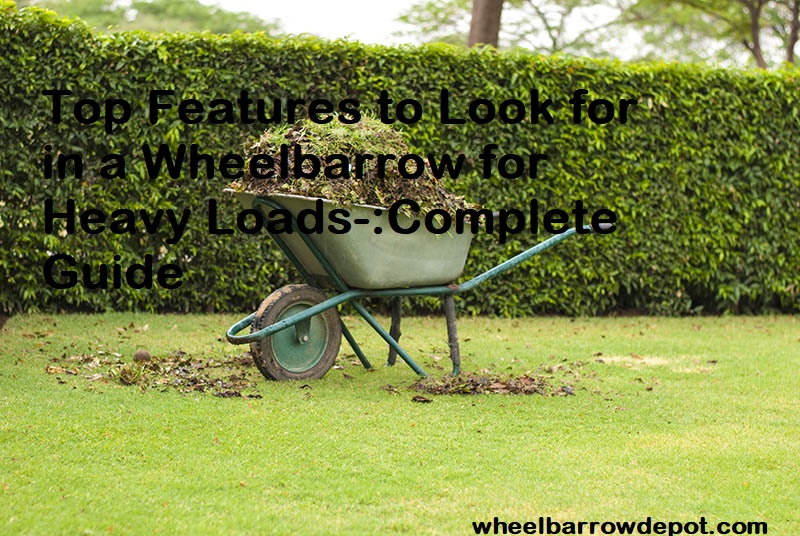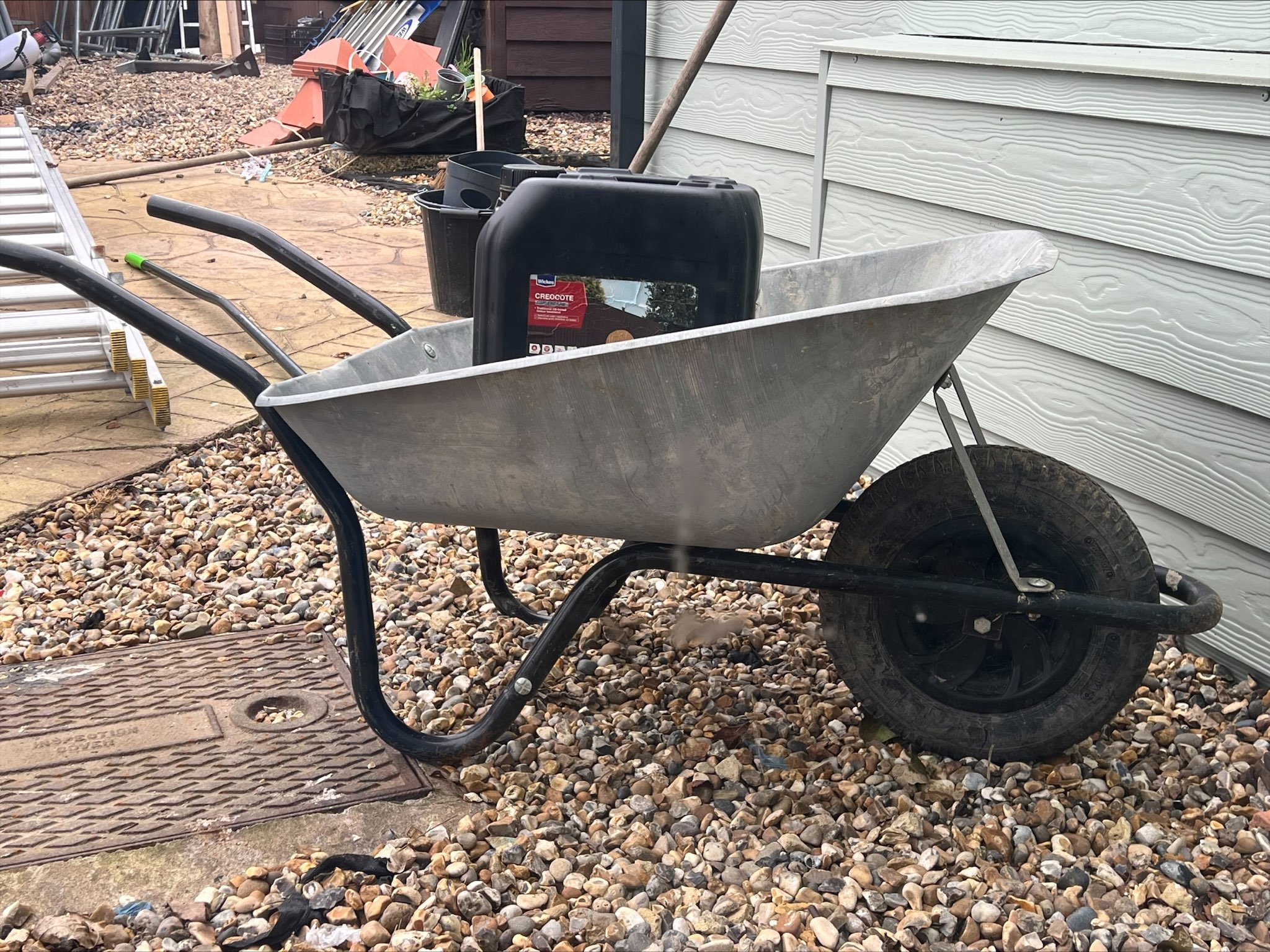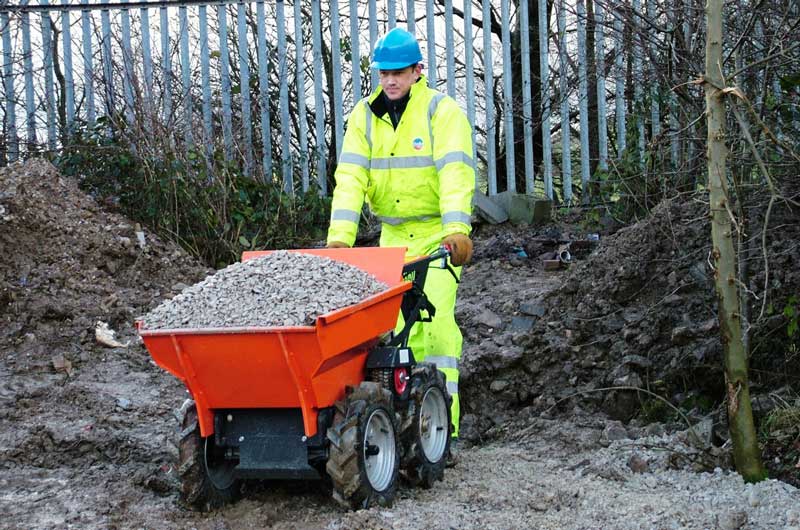Are you looking for a wheelbarrow to carry heavy loads but are unsure of what features to look for? This comprehensive guide covers all the essential features you’ll need in a wheelbarrow to ensure effective, stress-free handling of heavy loads. You’ll learn everything from load capacity and wheel size to handle grip and bed design.
Let’s get started!
In this guide, we will discuss the top features to look for when purchasing a wheelbarrow for heavy loads. To begin, it is important to understand some basic information about wheelbarrows and their components. A wheelbarrow is an essential tool in many industries, as they provide a convenient and efficient way to move heavy objects with ease.
When shopping for a wheelbarrow, you will find models with either one or two wheels. Two-wheeled wheelbarrows are the most popular option for heavy-duty applications because the two wheels provide added stability and support. Single-wheeled wheelbarrows are often lighter in weight and easier to maneuver but can be prone to tipping over when loaded with large and heavy objects.
When researching a wheelbarrow for heavy loads, there are several key features that should not be overlooked. These include: frame construction, puncture proof tires, capacity rating, handles and position adjustability, dump feature and ergonomic design elements such as balanced handles or comfortable foam grips. In this guide, we’ll take an in-depth look at each of these factors and explain why they are important when choosing a wheelbarrow that can handle your heaviest loads with ease.

Wheel Type
Depending on the job you need to do and the terrain you will be using it on, there are several different wheel types to choose from. Let’s take a look at your options.
Pneumatic Wheels: For heavy loads on hard surfaces such as asphalt, pneumatic wheels are your best option. These air filled rubber wheels can absorb shocks cause by bumps in the terrain and are much easier to push than other wheel types.
Semi-pneumatic Wheels: This type of wheel is a combination of pneumatic rubber and solid rubber, so it has some of the shock absorbing qualities but not as many as pneumatic. These are best for use on asphalt and concrete, but can also work well on gravel surfaces with some difficulty.
Solid Rubber Wheels: Solid rubber wheels can easily handle high loads over any type of terrain,but they don’t cushion bumps like pneumatic wheels do. This makes them less comfortable to use but is ideal for difficult jobs that require stability over vibration dampening ability. Often used for industrial applications or landscaping, these may be your go-to if you want something that won’t break down over time or wear out quickly due to constant use.
Polyurethane Wheels: Made of hard plastic covering foam or air filled voids, polyurethane (or plastic) wheels offer good traction while being easy to maneuver. They can handle most terrains including grass and loose soil with ease but are not ideal for heavier loads or long hikes due to their lack of shock absorption capability compared with other wheel types.
Importance of wheel type for heavy loads
When purchasing a wheelbarrow for heavy loads, it is important to understand the type of wheel that best suits your needs. Different wheels can provide certain advantages that are suitable for different types of tasks, and choosing the wrong type of wheel can result in inefficient loading, walking and unloading. Consider the following important factors when selecting an appropriate wheelbarrow:
- Size – Wheelbarrows come in many different sizes; select one based on how much weight you plan to use on a regular basis. If you are primarily moving heavy loads with your wheelbarrow, select one with larger wheels (eight to ten inches). This will reduce the amount of stress and physical effort needed to move or turn your barrow since larger wheels make it easier to transport bigger items.
- Durability – It is important that the material used on your wheel be hard wearing and long lasting, so investing in a quality product is paramount if you want consistent performance from your barrow over time. Rubber or composite wheels provide good traction and superior shock absorption compared to pneumatic tires, making them ideal for heavily laden barrows as they wear down more slowly and don’t deflate as quickly after multiple uses.
- Comfort– It is also important to consider if you will be using manual or powered push/pull devices; selecting a suitable type of tire for the terrain you plan on navigating can make a significant difference in terms of comfort during operation. For example, if you will be transporting your load over rougher terrain then wider tires might be beneficial as they cushion better than smoother tires due their greater surface area contact with the ground – this applies both manually pushed and powered versions of a load hauling device alike!
Common types of wheels for wheelbarrows
Wheels are a key component of wheelbarrows and the type of wheel can make a big difference in how easy it is to move your load. Generally, there are four types of wheels used on wheelbarrows – pneumatic, foam filled, solid rubber and spoke-like designs.
Pneumatic wheels provide cushioning and shock absorption, making them ideal for use on hard surfaces like asphalt or concrete. They may cost more however since they contain a tube and an outer tire, both of which need to be replaced if they become worn out or damaged. Pneumatic wheels usually come with either a deep-tread all-terrain pattern, or an easy rolling smooth tread for pavement or garden paths.
Foam filled wheels tend to be slightly cheaper than pneumatic ones but are less durable due to the lowers quality rubber used in manufacture. They don’t generally require any maintenance and don’t go flat easily so they’re still suitable for certain applications but are not as good as other wheel types over rough terrain.
Solid rubber is the longest lasting type of wheel and provides smooth rolling performance as well as durability. These heavy duty tires have smaller treads than the others with fewer nooks and crannies for dirt and debris to get stuck in and wear them down more quickly than other types worse over time.
Lastly, spoke-like designs offer extra maneuverability on rough terrain due to their wide contact area – they give far greater control when negotiating turns but do not provide cushioning or shock absorption characteristics. The spoke-like patterns also allow better grip on wet surfaces due to improved water drainage which can help prevent slipping during heavy loads lifting activities.
Recommended wheel types for heavy loads
When shopping for a wheelbarrow suitable for carrying heavy loads, the type of wheel is an important factor to consider. Depending on the type of terrain in your yard or garden, you’ll need to choose from three different categories: air-filled tires, solid rubber wheels, or pneumatic-style tires.
Air-filled tires are very popular due to their lightweight and shock absorbing capabilities, which provide maneuverability and traction when hauling heavier weights. These types of wheels are most often used in lighter loads and on flatter surfaces such as roads and sidewalks. The downside is that they don’t last as long under extreme conditions; they will eventually get flat with overuse or if punctured.
Solid rubber wheels are a great choice for heavy loads as they offer superior puncture resistance, taking into account that they won’t go flat during use. They also hold up well over uneven paths or areas with obstacles such as stones and roots; however, since they are heavier than air-filled tires this will affect their overall performance on certain surfaces.
Pneumatic-style tires provide excellent shock absorption for heavy hauling purposes but require more effort to move due to their heftiness. This type of tire usually has thicker sidewalls than air-filled tires which helps them absorb serious blows from off-road surfaces like deep grass or dirt roads without compromising the rimbase construction.. They may require more maintenance then regular wheels but with proper care will last long years in service providing you with extra pulling power when needed carry heavy loads anywhere with confidence.
III. Material
The material used to construct the wheelbarrows makes a big difference in their durability and load-bearing capability. Wheelbarrows can be made with metal, plastic, or wood. Metal wheelbarrows are typically the most durable, allowing them to be used for heavy loads as they will not crack or break easily. However, metal wheelbarrows are also more expensive and heavier to carry than other options.
Plastic wheelbarrows are usually less expensive than metal wheelbarrow and light-weight making them easier to transport. However, the advantage of plastic comes at a cost as these wheelbarrows tend to break more easily and can’t handle loads as heavy as those with metal construction.
Wooden wheelbarrows are often more attractive in design than either metal or plastic options, but they also tend to be heavier and less durable; therefore, wooden wheelbarrow may not be suitable for heavy loads.
Importance of material for wheelbarrows
When looking for a wheelbarrow for heavy loads, it is important to take into account the type of material used in its construction. The material affects the durability and quality of the wheelbarrow and can have a significant impact on its performance.
Generally speaking, wheelbarrows for heavy loads should be made from strong and durable materials such as steel or aluminum. This ensures that it can easily carry large quantities of weight without getting damaged over time.
It is also important to ensure that the construction is sturdy enough so that it does not shake or wobble when being pushed around. Additionally, make sure that any parts that are susceptible to rust or corrosion are treated with a suitable rust-proof coating.

Common materials used for wheelbarrows
Wheelbarrows are made out of a variety of materials, each with its own pros and cons. It’s important to consider the type of wheelbarrow that best fits your needs while taking into account the possible trade-offs. Common materials used for wheelbarrows include metal, plastic, and wood.
Metal: Metal wheelbarrows are usually constructed with metal frames and a flat bottom tray usually made out of metal or polymer liners. They can be more expensive than their plastic counterparts, but they often offer superior stability when pushing and maneuvering heavy objects.
Plastic: Plastic wheelbarrows are lighter than their metal counterparts and generally have shorter lifespans due to wear-and-tear from repeated use. However, plastic wheelbarrows may be better suited for lighter items and easier maneuverability on uneven terrains such as sandy beaches or rough terrain.
Wood: Wood is a timeless choice for construction work but not often seen in commercial wheelbarrow applications today due to advancements in technology that make stronger metals available at lower cost points. If a wooden component is necessary for a specialized application such as an art piece or organic farming toolbox, handcrafted wooden wheelbarrows can provide excellent durability and functionality under light loads.
Recommended materials for heavy loads
When choosing a wheelbarrow for heavy loads, it is important to consider the type of materials that are used in the construction. There are several different options to choose from, including steel, aluminum, and polyethylene. Steel is often considered to be the most resilient, but can be quite heavy due to its density. For lighter loads which require a greater load carrying capacity, aluminum or polyethylene may prove more suitable.
At the same time it is important to bear in mind that all materials will have their pros and cons as far as performance and lifetime usage goes. A lightweight aluminum wheelbarrow might be ideal for occasional use, for example when moving plants around the garden but will not necessarily have enough strength for larger, heavier items such as bricks or large planters. In this case a more robust and robustly built steel model would provide much better value for money over time.
Maintenance and Storage
It is important to ensure that your wheelbarrow is properly maintained and stored for maximum performance. Wheelbarrows are designed to handle heavy loads, therefore improper care can result in excessive wear and tear over time. Here are some tips on maintaining and storing your wheelbarrow:
- Inspect the wheelbarrow regularly to make sure ground or debris has not become lodged in the wheel spokes or axle, which could cause wheel damage. If needed, use a wire brush to remove any debris that may have accumulated during use.
- Clean wash your wheelbarrow with soapy water after each usage session, drying it off before storing to avoid rusting of any metal parts such as the handles and axles.
- Oil or grease ball bearings and other moving parts such as gears monthly or as necessary to prevent wear-and-tear issues caused by dry weather or infrequent usage of the wheelbarrow.
- Store your wheelbarrow indoors in an area that is dry and protected from all weather conditions for optimum care of your investment over time, especially if it is not in use for extended periods.
Importance of maintenance and storage
One of the most important factors to consider when selecting a wheelbarrow for your heavy loads is ease of maintenance and storage. Proper maintenance and storage of your wheelbarrow will increase its longevity and preserve its condition over time. Here are some pointers to consider:
- Ensure that all nuts, bolts and screws are always tight, as loose components may create an uneven weight distribution, cause poor balance or cause damage to the wheelbarrow during use.
- Empty the tray and wash it out after each use. This will prevent residual dirt and debris build up, which can corrode the metal or wood over time.
- Regularly inspect all moving parts such as handlebars, wheels and axles for signs of wear-and-tear, particularly with wooden handles which may rot faster due to exposure to water.
- Amount of space needed for storage should be considered when selecting your model – larger models may require a dedicated space in a garage or shed as they take up considerable amounts of room when not in use!
- If you plan on leaving the wheelbarrow outside during bad weather conditions such as rain or snowfall, ensure you invest in one with adequate waterproofing capabilities to prevent rusting damage from occurring.
Recommended maintenance and storage practices
In order to ensure your wheelbarrow is well-maintained, certain practices should be followed. This includes regular check-ups of the tire pressure and tread, bearings, hardware and seals. Additionally, it’s important to check for any rust or wear which could lead to the breaking down of parts.
It is also important to keep your wheelbarrow in a cool and dry area when not in use. This will help protect it from the elements that can cause damage plus help preserve it so that it can last longer. Additionally, cleaning your wheelbarrow often with a hose or soap and water will prevent dirt build-up which could lead to permanent damage. Lastly, applying oil on any rusty spots can help prolong the life of your wheelbarrow as well as protect it from further corrosion.
By following these recommendations you will ensure optimal performance from your wheelbarrow for many years to come!

Conclusion
In conclusion, there are a few key features to look for when selecting the best wheelbarrow for your heavy load needs.
First, you want to make sure the material is strong and durable, such as steel or composite plastic. Second, you want to ensure that the wheels are large enough to accommodate your load and do not wobble when in motion.
Third, you should select one with foam filled handles rather than those that are rubber coated or wrapped in leather or fabric grip tape. Finally, even though cost should be considered the last factor in your selection process, it is still an important one; look for a quality product that offer reliable customer service and a replaceable part guarantee before making your purchase.
As long as you pick one of these top-notch wheelbarrows with these features in mind, you can make sure that no matter how heavy the load is it will be safe and stable when transported.
FAQ’s
What should I look for in a wheelbarrow?
When looking for a wheelbarrow, you should consider its size, weight capacity, material, wheel type, and handle design.
What are the features of a wheelbarrow?
The features of a wheelbarrow may include a metal or plastic tray, one or two wheels, pneumatic or solid tires, cushioned grips, and a lifting mechanism for dumping.
How much weight can a wheelbarrow handle?
The weight capacity of a wheelbarrow varies depending on its size and design, but most can handle between 100-200 pounds.
How can I make my wheelbarrow stronger?
You can make your wheelbarrow stronger by reinforcing the tray with plywood or metal, upgrading the wheel and tire, and replacing worn-out parts.
What is the best brand of wheelbarrow?
There is no single “best” brand of wheelbarrow, as it depends on your specific needs and preferences. Some popular brands include Ames, True Temper, and Gorilla Carts.
How do you calculate the mechanical advantage of a wheelbarrow?
The mechanical advantage of a wheelbarrow can be calculated by dividing the length of the handles by the distance from the wheel axle to the point where the load is placed.
Is a 1 or 2 wheel wheelbarrow better?
A 1-wheel wheelbarrow is generally more maneuverable, while a 2-wheel wheelbarrow is more stable and easier to balance.
What is the classification of wheelbarrow?
Wheelbarrows can be classified based on their design, material, weight capacity, and intended use.
How do you calculate wheelbarrow load?
To calculate the load capacity of a wheelbarrow, you need to know the volume of the tray and the weight of the material you are carrying.
What is the average volume of a wheelbarrow?
The average volume of a wheelbarrow is around 6 cubic feet, although it can vary depending on the size and design of the wheelbarrow.
See more-
- Best wheelbarrow for yard work 2023
- Best wheelbarrow for women 2023
- Best wheelbarrow for cement 2023
- Best wheelbarrow for tall people 2023
- Best wheelbarrow for concrete 2023

Richard Tolliver is a seasoned author and the CEO of a popular wheelbarrowdepot and informative website. With a degree in Horticulture from the University of Missouri, he worked as a professional landscaper and garden designer for several years. His website, founded in 2010, offers comprehensive and unbiased reviews of the best wheelbarrows available in the market, helping readers make informed decisions based on their needs and budget. His expertise and knowledge have been recognized by industry professionals, and he continues to inspire gardening enthusiasts and outdoor enthusiasts alike with his personal experiences and tips on creating beautiful and sustainable outdoor spaces.

